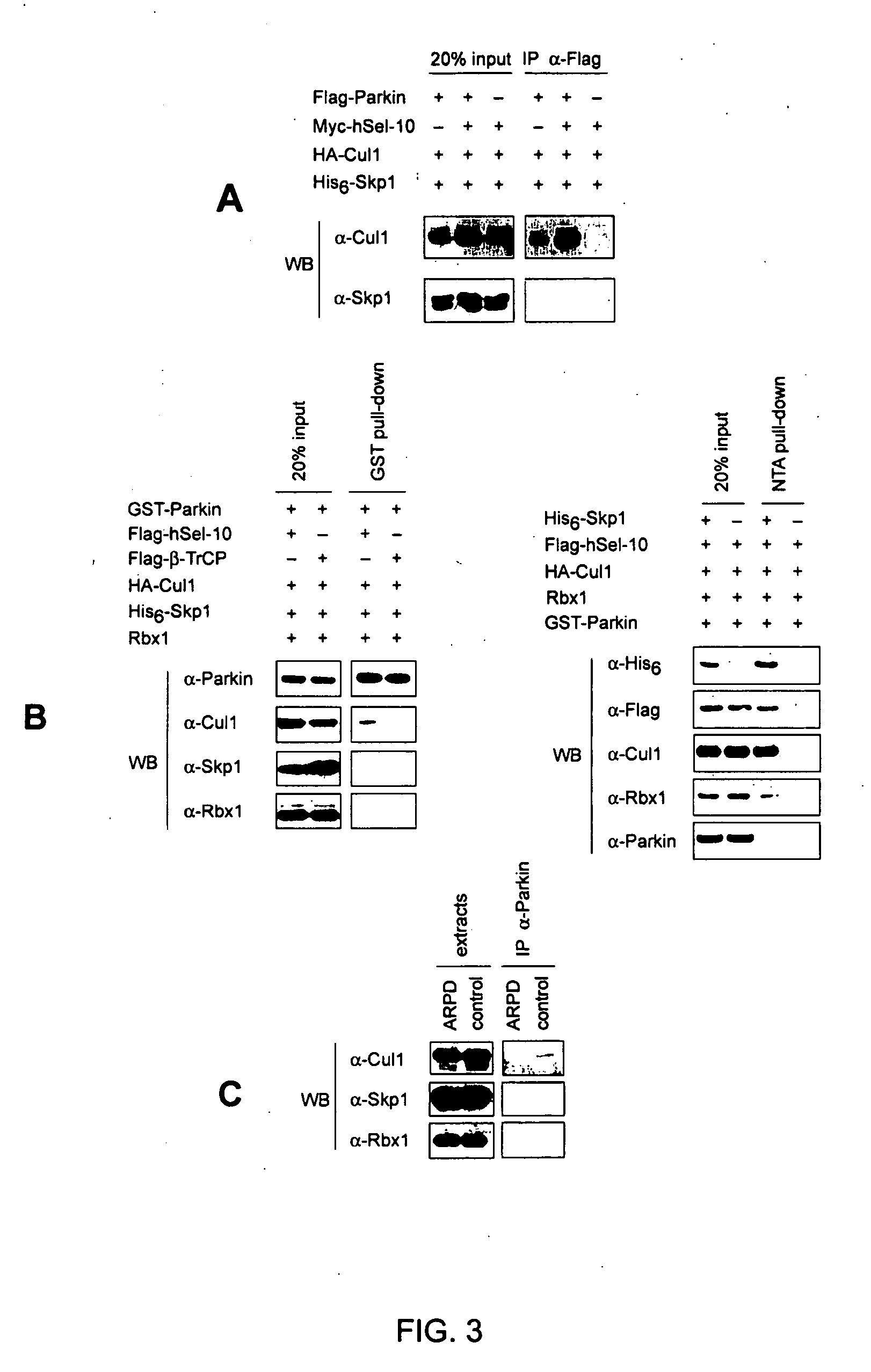Vector-mediated gene regulation in midbrain dopamine neurons
a dopamine neuron and gene regulation technology, applied in the field of vector-mediated gene regulation in midbrain dopamine neurons, can solve the problems of no known cure for pd, no dopamine deficiency in parkinson's patients, and proteasomal dysfunction, and achieve the effect of protecting in vitro
- Summary
- Abstract
- Description
- Claims
- Application Information
AI Technical Summary
Benefits of technology
Problems solved by technology
Method used
Image
Examples
example 1
Expression Vectors, Cell Cultures and Antibodies
[0087] cDNAs for parkin, UbcH7, α-synuclein, and UbcH8 were PCR-amplified from a human liver cDNA library (Clontech), and cloned into the eukaryotic expression vectors, pCMS-EGFP (Clontech) or pcDNA3.1. Flag-parkin, T240R parkin, Flag-T240R parkin, and ΔUHD parkin were generated by PCR-mediated mutagenesis. A cDNA clone encoding PP2A / Bα was obtained from Research Genetics. HSel-10 constructs have been described (Wu et al., SEL-10 is an inhibitor of Notch signaling that targets Notch for ubiquitin-mediated protein degradation. Mol. Cell Biol., 21:7403-15, 2001). The integrity of all constructs was confirmed by automated sequencing. Recombinant baculoviruses expressing GST-tagged parkin were generated using the Baculogold system (Pharmingen), as per the manufacturer's instructions.
[0088] HeLa cells were maintained in Dulbecco's Modified Eagle Medium (Life Technologies), supplemented with 10% fetal bovine serum (Life Technologies), and...
example 2
Generation of DJ-1 Deficient ES Cells
[0128] To investigate the normal cellular function of DJ-1 and the pathogenic mechanism of the PD mutations, the inventors generated cells deficient in DJ-1. A murine embryonic stem (ES) cell clone, F063A04, that harbors a retroviral insertion at the DJ-1 locus was obtained through the German Gene Trap Consortium (Tikus web site) (Floss and Wurst 2002). The pT1ATGβgeo gene trap vector is present between exons 6 and 7 of the murine DJ-1 gene, as determined by cDNA sequencing of trapped transcripts and genomic analysis (FIG. 14A). This integration is predicted to disrupt the normal splicing of DJ-1, leading to the generation of a truncated protein that lacks the carboxy-terminal domain required for dimerization and stability (data not shown). Of note, a mutation that encodes a similarly truncated protein (at the human DJ-1 exon 7 splice acceptor) has been described in a patient with early-onset PD (Hague et al. 2003).
[0129] To select for ES subc...
example 3
DJ-1 Lacks Apparent Protease and Antioxidant Activities In Vitro
[0149] DJ-1 homologs have been reported to harbor protease (Halio et al. 1996; Du et al. 2000; Lee et al. 2003) and amidotransferase activities (Horvath and Grishin 2001). However, crystal structure analyses of DJ-1 suggest that this protein may not retain such catalytic activities (Honbou et al. 2003a; Huai et al. 2003; Lee et al. 2003; Tao and Tong 2003; Wilson et al. 2003). Consistent with this, purified DJ-1 preparations failed to display in vitro protease activity toward a variety of synthetic or natural substrates, and, similarly, DJ-1 lacked antioxidant (FIG. 32) or catalase activities (FIG. 28) in vitro. Furthermore, cells deficient in DJ-1 appear unaltered in the initial accumulation of ROS in the context of acute oxidative stress (Martinat et al. 2004).
DJ-1 is a Redox-Dependent Molecular Chaperone
[0150] Every organism responds to ROS and other toxic environmental stresses by overexpressing a highly conser...
PUM
| Property | Measurement | Unit |
|---|---|---|
| concentrations | aaaaa | aaaaa |
| integration time | aaaaa | aaaaa |
| integration time | aaaaa | aaaaa |
Abstract
Description
Claims
Application Information
 Login to View More
Login to View More - R&D
- Intellectual Property
- Life Sciences
- Materials
- Tech Scout
- Unparalleled Data Quality
- Higher Quality Content
- 60% Fewer Hallucinations
Browse by: Latest US Patents, China's latest patents, Technical Efficacy Thesaurus, Application Domain, Technology Topic, Popular Technical Reports.
© 2025 PatSnap. All rights reserved.Legal|Privacy policy|Modern Slavery Act Transparency Statement|Sitemap|About US| Contact US: help@patsnap.com



